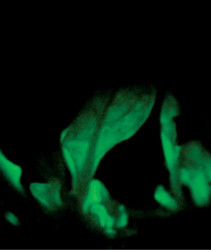Glowing Plants: The Next Big Opportunity?

The notion of plants glowing in the dark is a captivating one. From the Scarlet Flower based in Slavic folklore to the Pandora forests in the movie “Avatar,” people have been mesmerized by the possibility of plants and flowers illuminating the night.
In the past, both scientists and growers have tried to make plants glow, and these attempts have been noticed by the general and science media. However, all of the “glowing plants” generated so far required either chemicals to be sprayed on them to induce glow for a short period of time, or external “black light” illumination to achieve the glow-like effect–or both.
Some recent examples are illuminating roses and mums sold under the brand name Glowing Flowers at the FloraHolland auction in Naaldwijk, Netherlands. These plants have been treated with a patented dye and then exposed to daylight or black light to “charge” them to emit light for a limited period of time. Both have sold at about 50 percent more than what the untreated flowers sell for, demonstrating that people are so excited by plants glowing in the dark that they’re even prepared to pay a premium for them.
New Technology
Now, the next generation of glowing plants is here. Bioglow, a biotechnology company that specializes in state-of-the-art genetic engineering, has developed a transgenic technology that enables living plants to emit light visible to the naked human eye. Unlike other glowing plants, the glow of these new autonomously luminescent (autoluminescent) plants is a natural part of the plant’s life cycle and is not dependent on any chemicals or external black light sources. The autoluminescent plants are an environmentally friendly and cost-effective alternative.
The autoluminescent plants were generated using an advanced genetic engineering approach. A complete metabolic pathway required for light emission has been genetically engineered into the plant’s genetic material, becoming an integral part of the plant and allowing for inherent light emission. The glow continues throughout the life of the plant and is stable from generation to generation.
Just like the firefly or any other naturally glowing organism, autoluminescent plants simply glow. The prototype plants developed by Bioglow belong to nicotiana species–the model organism in plant molecular research.
Impressions
Bioglow invited several growers and retailers from the New York City area to check out the autoluminescent plants firsthand. Here are a few impressions:
– “I was intrigued when I received a phone call from Alex and his partners asking me if I would be interested in seeing glowing plants. Although the Nicotiana plants glowed only feebly, Alex explained it would be possible to produce robustly glowing plants in the near future. He then went on to describe the limitless possibilities of transgenic technology. Leaving there, I could not help but feel that floriculture as I understood it was about to change dramatically.”–Jeff Keil, manager and grower, Otto Keil Florists
– “Seeing plants glow was a remarkable experience. I am very excited about glowing plants and believe they will be a significant introduction to the industry. Glowing plant technology can enhance the landscape, offering unique and beautiful changes to both perennial and annual plantings and beds. Seasonal displays will also benefit from the addition of glowing stems. The possibilities are endless. Landscaping with glowing plants may also help to conserve electricity, limiting the need for electric landscape lighting regularly used in gardens. I have no doubt consumers will be thrilled to see living glowing plants outside their homes and in their private gardens.”–Noah Schwartz, head grower, Garden State Growers
What’s Next?
The first glowing Nicotiana prototype plant is, as Keil points out, relatively dim and requires dark-adapted eyes to see. Bioglow is currently working on enhancing light output levels of the autoluminescent plants, increasing their aesthetic appeal and making them more charming.
Bioglow’s technology potentially enables conversion of essentially any plant species into a glowing variety. Moreover, the emitted light can further be modified in color and even segregated to specific plant parts (i.e. leaves, flowers), providing for an essentially unlimited variety of glowing plants.
The experience with prototype Nicotiana plants shows glowing plants do not require any special treatment and do not differ in any regard–growth rate, size, etc.–from their regular, non-glowing counterparts. The plants demonstrate that growing autoluminescent plants will fit perfectly into the existing practices of the floriculture industry.
The autoluminescent plants are aimed to captivate the consumer’s imagination. One can envision a wide range of glowing plants as consumer products, from exclusive glowing plants for weddings and high-end private gardens to landscape plants lighting driveways and backyards.









